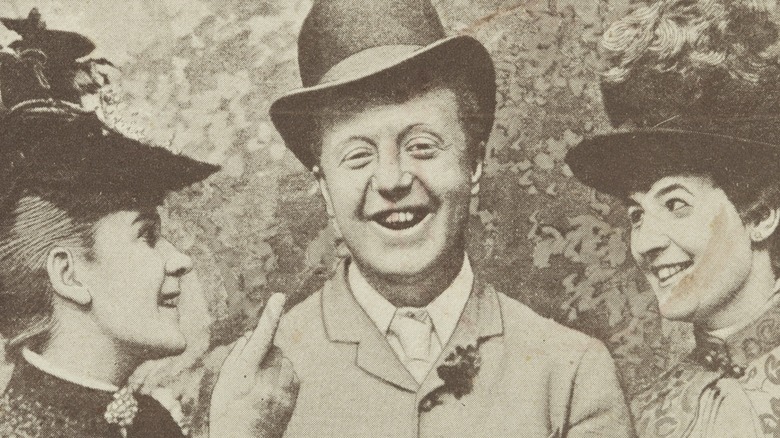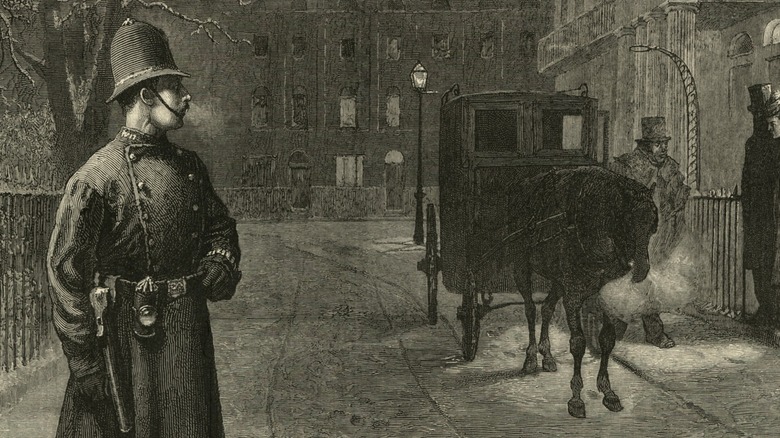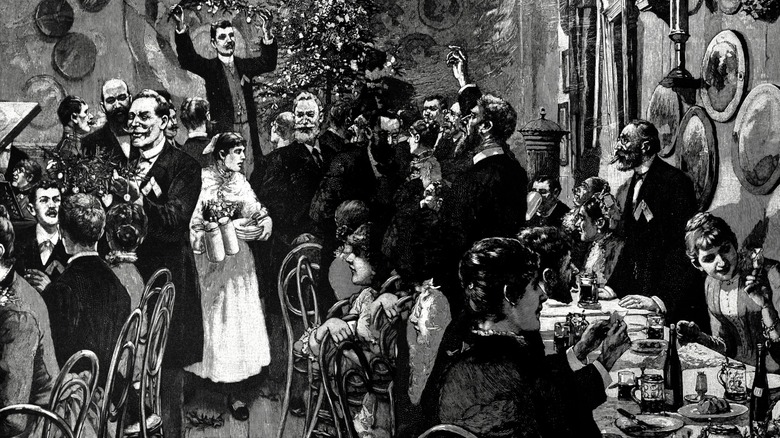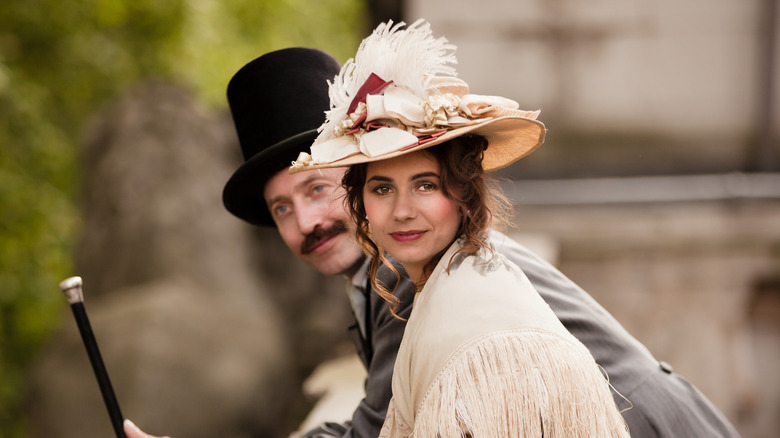5 Sayings From The Victorian Era We Still Use Today
"Now, now, there's no need to beat around the bush. Just get on with it and spill the beans. You've been caught red-handed, and — pardon my French — I've got to steal your thunder, by Jove! A little bird told me what happened, and now that it's been dragged into the limelight, you're in a pickle, alright. So fess up and get on with it, or you'll never paint the town red again!"
Though that dialogue is low on specifics, no doubt you understand the general scenario: Someone did something bad and got called out on it. It sounds old-timey, sure, maybe like a 1940s radio broadcast delivered in a Transatlantic accent that evolved from American theater in the early 1900s. And indeed, all the idiomatic phrases in that dialogue — "beat around the bush," "spill the beans," "caught red-handed," "pardon my French," etc. — were already in common use by the time the early 20th century rolled around. Those phrases, and many more, were in use during a critical juncture in history that overlapped with the insatiable industrialism of the Gilded Age in the U.S. and the alienation and decadence of the Belle Epoque in France: England's Victorian Era (1837 to 1901).
Some phrases from the Victorian Era have roots in the chemical and technological noodlings of the time, like "mad as a hatter" (poisonous mercury was used to make hats) or "in the limelight" (lime was used in spotlights for stages). Others are far older and pop up in Shakespeare ("in a pickle") or even the Bible ("a little bird told me"), but were used through Victorian times. But in all cases, neither you nor a Victorian would have any trouble understanding each other.
Blow off some steam
When you're mad, you've got to go blow off some steam, right? Maybe you hit the gym and blast some metal in your earphones. Maybe you go for a long, winding night drive with the window down. But no matter how you blow off steam, the analogy makes sense. An object gets hot (angry) and needs to lose heat and energy (steam) to regain composure. But why steam, anyway? Well, it all goes back to the Industrial Revolution.
Though the Industrial Revolution (1733 to 1913) didn't perfectly overlap with the reign of Queen Victoria (1837 to 1901), it did reach a head in the 19th century. Factories replaced farms, machines replaced people, workers moved to urban spaces, living and working conditions became horrible, and we wound up with soot-laden Dickensian chimney-sweeps climbing into tiny spaces and getting stuck and dying. Steam engines were everywhere, a technology going back to a 1690 patent featuring a hand pump steam machine. By 1800, Britain had 2,500 steam engines in factories, cotton mills, and mines. By 1804, steam locomotives started chugging down the tracks and belching steam from smokestacks.
Folks must have made the connection between hulking, loud, metal monstrosities and human rage pretty quickly, because by 1837, the phrase "blow off some steam" shows up in the Frederick Marryat novel, "Snarleyyow, or, the Dog Fiend." Writing of a widow, Marryat says that she, "sat in the chair fuming and blowing off her steam." He also mentions "the power of some stupendous steam-engine" at a different point. His use of the phrase is so casual that it feels like it was already commonplace by then, though there's no way to know for sure.
Keep your eyes peeled
"Keep your eyes peeled" is actually a pretty grotesque phrase if you take it literally. But thankfully, if someone tells you to keep your eyes peeled, they're not suggesting that you reach for the nearest potato peeler and blind yourself. It means watch out, keep watch, keep an eye out (a more literal version of the phrase), and so forth. But where in the heck does the whole "peeled" thing come from? A Victorian orange hunt? One theory is that it comes from Mr. Peel, of course — Sir Robert Peel (1788 to 1850). We've also got Sir Peel to thank our phrase and the familiar term "bobby," slang for police officer.
Prior to the reign of Queen Victoria, it took all the way until 1829 for the Metropolitan Police Act to pass and London to get its sorely needed police force. Peel was in charge of the force, and his officers became known as "peelers." Peel's initial rollout of 1,000 peelers had the typical truncheon you'd envision, plus handcuffs and an attention-grabbing rattle that got replaced with a whistle in 1880. Not just anyone could be a peeler, though. Peelers had to be 20 to 27 years old, at least 5-foot, 7-inches tall, be in good physical health, be able to read, and have a spotless criminal history.
It must have been a simple jump from Peel's peelers to keeping one's eyes peeled, as the phrase shows up in print in 1853 in St. Louis, Missouri, all the way across the Atlantic. As The Optical Journal cites, St. Louis' Daily Morning Herald advised, "Young man! Keep your eye peeled when you are after the women." Assumedly, the writer was referring to courtship opportunities, not criminal activity.
Painting the town red
You know how a typical night out goes. You knock back some drinks with your friends, you're refused entry into a town because you're totally soused, so you decide to board up the windows of the dude who refused you entry. He shoots at you, you run away, you slip into town anyway, go on a rampage and destroy some flowerpots, tear down some signs, flip over a vehicle, get ahold of some red paint, and start streaking random people's houses with paint like a real jerk. Fast forward 188 years, and some folks are writing articles about how you "painted the town red."
Indeed, it seems like this is the origin of the phrase, "painting the town red." Back in 1837, the Marquis of Waterford and his rich, presumably young friends didn't merely have a fun night out, like we'd use the phrase today; they did exactly what we described above. Being 1837, this was the first year of the reign of Queen Victoria and the same year that Frederick Marryat wrote about blowing off steam in Snarleyyow, or, the Dog Fiend. It looks like the Marquis of Waterford and his mates did exactly this. They each paid £100 in fines for their crimes, or about £14,300 modernly.
From there, it's always difficult to link up the origin of a phrase with its common use. There are even some competing theories about the origins of painting the town red, from Dante's "Divine Comedy" (mentioned by Oscar Wilde) to a written fireworks reference in 1884 Chicago. Regardless, Victorians knew what it meant, and so do we.
Mad as a hatter
Possibly one of the most well-known Victorian phrases and also the least wieldy in conversation, we've got "mad as a hatter." The origin of this phrase is pretty well-known thanks to the Mad Hatter character in Lewis Carroll's beloved Victorian children's novel, "Alice's Adventures in Wonderland" (1865) and its sequel, "Through the Looking-Glass, and What Alice Found There " (1871). Although, funny enough, the name "Mad Hatter" is never mentioned in the books, just, "Hatter." But yes, he's quite mad. It must have been all the mercury poisoning.
Being a time of chemical and technological advancement and experimentation, some things were bound to go wrong during the reign of Queen Victoria. Like, Dr. MacKenzie's Improved Arsenic Complexion (ingestible) Wafers wrong, or lead and radium in makeup wrong — just two out of a host of lethal beauty products that slipped into the Victorian hygiene market. Then there was all the mercurous nitrate used to cure the felt in hats. Hatmakers across the board breathed in mercury vapors that resulted in early symptoms like rashes and digestive problems, but escalated to bodily tremors, dysarthria (slurred speech), and generally unstable emotions. Hatters didn't get as erratic as the Hatter from Carroll's books, but the reputation stuck, nonetheless.
Carroll wasn't the first one to make the mercury-hatter connection, though. Five years earlier in 1860, J. Addision Freeman, M.D., wrote about "mercurialism" in Transactions of the Medical Society of New Jersey. The problem eventually got so pervasive that doctors coined the term "Mad Hatter's Disease," or "Erethism" by its official name. Even and unbelievably so, mercury continued to be used in hats all the way to 1941. Talk about mad as a hatter.
In the limelight
"In the spotlight" is an ultra-clear, literal phrase, but what about "in the limelight"? Nowadays, it refers to a more general notion of being the center of public attention, but when the phrase came into use it referred to spotlights projected using actual lime. The chemical tinkering underpinning limelight is honestly pretty impressive, and typifies not the worst side of Victorian experimentation, like ingestible arsenic wafers, but the best.
In 1820, English surgeon and chemist Goldsworthy Gurney combined quicklime (calcium oxide) with a combination of lit hydrogen and oxygen to produce a brilliant, intense white light. By funneling the flame through a tube and towards the fire, he had a long-lasting, extremely bright light source that wouldn't melt the quicklime because quicklime melts at over 4,600 degrees Fahrenheit. Scottish engineer Thomas Drummond took Gurney's work and made it into a functional product that worked so well it got referred to as "Drummond light." Come 1837 — the year that Queen Victoria came to power, yet again — and "limelights" made their way through theaters, lighting up those on stage.
Limelights were standard in theaters until they got replaced by Thomas Edison's commercially viable electric lightbulb, which went into production in 1880. Also note: Edison didn't "invent" the bulb; he just patented a refined version of it, much like Drummond did with limelight. But such is the way for an uproariously inventive time like the Victorian Era, or any other, really. But no matter that limelights fell out of use, we still invoke their name anytime we describe someone being a talked-about public figure.





